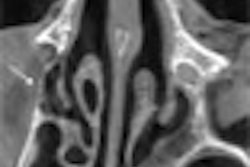The term satisfaction of search (SOS) refers to a lesion that is missed after another lesion is found within the same image. In an x-ray experiment, SOS occurs when an abnormality was missed in the presence of an added abnormality, but not in its absence. Researchers from Iowa studied the use of a formatted checklist to see if it could reduce SOS errors in chest radiography.
The study was conducted through the departments of radiology and psychology at the University of Iowa in Iowa City. For this research, the authors used the same two SOS conditions from their previous research: presentation of each chest radiograph with and without a simulated pulmonary nodule (Academic Radiology, November 2000, Vol. 7:11, pp. 945-958).
A total of 57 x-rays were used for the current study. Thirty had diverse, subtle, and clinically important native abnormalities; 27 had no native abnormalities. "The examinations were presented in two conditions: one with and one without the simulated pulmonary nodule. As in other SOS experiments, the detection accuracy for native abnormalities was compared with that for those same abnormalities when a simulated pulmonary nodules was introduced," the authors wrote. Native abnormalities included those of the lungs, great vessels, chest wall, and abdomen (Academic Radiology, March 2006, Vol. 13:3, pp. 296-304).
The checklist began with a "global Gestalt" category. The second item on the checklist was "lungs." Categories and the order they appeared were based on the most common patterns of search as set out by a previous study on the role of a verbalized chest x-ray reading protocol (Academic Radiology, December 2000, Vol. 7:12, pp. 1098-1106).
Twenty radiologists participated and none of them had taken part in previous SOS studies. Each observer was asked to inspect the x-ray until an abnormality was discovered, or until he or she was certain that no abnormalities were present. The readers also completed a questionnaire that posed such queries as "Did the particular order of search areas on the checklist interfere with your normal search strategy?"
According to the results, there was no SOS reduction in the average area under the receiver operator characteristic (ROC) curve. In fact, the authors found that ROC performance was worse with the checklist when pitted against a verbal protocol (0.68 versus 0.75, p < 0.001).
Of the 20 radiologists, 18 said that they found the checklist tedious and time-consuming. Only half said that they would consider using a checklist while reading. However, those who reported that they would be willing to do so had a lower ROC area than those who would not use a checklist (0.64 versus 0.71, p < 0.05). Also, those who reported that they would use a checklist had a greater SOS effect.
"An actual checklist does not shield (radiologists) for SOS in such a helpful way," the authors concluded. "The idea was that a checklist might help prepare the observer for unexpected types of abnormalities and overcome inadequate clinical information. The current ROC area results show that a checklist fails to prevent the SOS effect in chest radiology."
One reason for this failure may be because the checklist undermines the reader's own cognitive plan, disrupting his or her natural pattern of perception, they added.
By Shalmali Pal
AuntMinnie.com staff writer
March 13, 2006
Related Reading
Chest x-ray after thoracentesis adds little new information, December 26, 2005
Revisiting report errors serves as educational tool for residents, December 22, 2005
Copyright © 2006 AuntMinnie.com



















